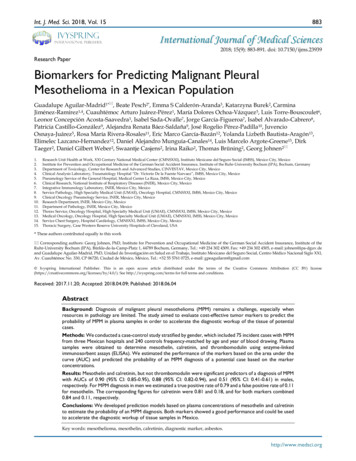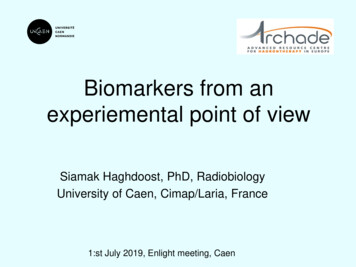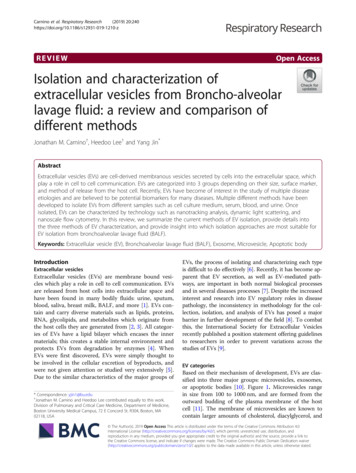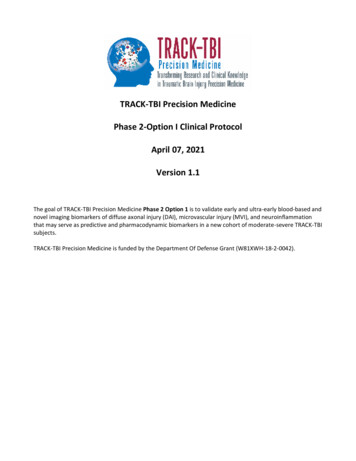
Transcription
Int. J. Med. Sci. 2018, Vol. 15IvyspringInternational Publisher883International Journal of Medical Sciences2018; 15(9): 883-891. doi: 10.7150/ijms.23939Research PaperBiomarkers for Predicting Malignant PleuralMesothelioma in a Mexican PopulationGuadalupe Aguilar-Madrid1* , Beate Pesch2*, Emma S Calderón-Aranda3, Katarzyna Burek2, CarminaJiménez-Ramírez1,4, Cuauhtémoc Arturo Juárez-Pérez1, María Dolores Ochoa-Vázquez5, Luis Torre-Bouscoulet6,Leonor Concepción Acosta-Saavedra3, Isabel Sada-Ovalle7, Jorge García-Figueroa7, Isabel Alvarado-Cabrero8,Patricia Castillo-González9, Alejandra Renata Báez-Saldaña9, José Rogelio Pérez-Padilla10, JuvencioOsnaya-Juárez5, Rosa María Rivera-Rosales11, Eric Marco García-Bazán12, Yolanda Lizbeth Bautista-Aragón13,Elimelec Lazcano-Hernandez12, Daniel Alejandro Munguía-Canales14, Luis Marcelo Argote-Greene15, DirkTaeger2, Daniel Gilbert Weber2, Swaantje Casjens2, Irina Raiko2, Thomas Brüning2, Georg Johnen2 1.2.3.4.5.6.7.8.9.10.11.12.13.14.15.Research Unit Health at Work, XXI Century National Medical Center (CMNSXXI), Instituto Mexicano del Seguro Social (IMSS), Mexico City, MexicoInstitute for Prevention and Occupational Medicine of the German Social Accident Insurance, Institute of the Ruhr-University Bochum (IPA), Bochum, GermanyDepartment of Toxicology, Center for Research and Advanced Studies, CINVESTAV, Mexico City, MexicoClinical Analysis Laboratory, Traumatology Hospital “Dr. Victorio De la Fuente Narvaez”, IMSS, Mexico City, MexicoPneumology Service of the General Hospital, Medical Center La Raza, IMSS, Mexico City, MexicoClinical Research, National Institute of Respiratory Diseases (INER), Mexico City, MexicoIntegrative Immunology Laboratory, INER, Mexico City, MexicoService Pathology, High Specialty Medical Unit (UMAE), Oncology Hospital, CMNSXXI, IMSS, Mexico City, MexicoClinical Oncology Pneumology Service, INER, Mexico City, MexicoResearch Department, INER, Mexico City, MexicoDepartment of Pathology, INER, Mexico City, MexicoThorax Service, Oncology Hospital, High Specialty Medical Unit (UMAE), CMNSXXI, IMSS, Mexico City, MexicoMedical Oncology, Oncology Hospital, High Specialty Medical Unit (UMAE), CMNSXXI, IMSS, Mexico City, MexicoService Chest Surgery, Hospital Cardiology, CMNSXXI, IMSS, Mexico City, MexicoThoracic Surgery, Case Western Reserve University Hospitals of Cleveland, USA* These authors contributed equally to this work Corresponding authors: Georg Johnen, PhD, Institute for Prevention and Occupational Medicine of the German Social Accident Insurance, Institute of theRuhr-University Bochum (IPA), Bürkle-de-la-Camp-Platz 1, 44789 Bochum, Germany, Tel.: 49 234 302 4509, Fax: 49 234 302 4505, e-mail: johnen@ipa-dguv.deand Guadalupe Aguilar-Madrid, PhD, Unidad de Investigación en Salud en el Trabajo, Instituto Mexicano del Seguro Social, Centro Médico Nacional Siglo XXI,Av. Cuauhtémoc No. 330, CP 06720, Ciudad de México, México, Tel.: 52 55 5761 0725, e-mail: gpeaguilarm@gmail.com Ivyspring International Publisher. This is an open access article distributed under the terms of the Creative Commons Attribution (CC BY) 0/). See http://ivyspring.com/terms for full terms and conditions.Received: 2017.11.20; Accepted: 2018.04.09; Published: 2018.06.04AbstractBackground: Diagnosis of malignant pleural mesothelioma (MPM) remains a challenge, especially whenresources in pathology are limited. The study aimed to evaluate cost-effective tumor markers to predict theprobability of MPM in plasma samples in order to accelerate the diagnostic workup of the tissue of potentialcases.Methods: We conducted a case-control study stratified by gender, which included 75 incident cases with MPMfrom three Mexican hospitals and 240 controls frequency-matched by age and year of blood drawing. Plasmasamples were obtained to determine mesothelin, calretinin, and thrombomodulin using enzyme-linkedimmunosorbent assays (ELISAs). We estimated the performance of the markers based on the area under thecurve (AUC) and predicted the probability of an MPM diagnosis of a potential case based on the markerconcentrations.Results: Mesothelin and calretinin, but not thrombomodulin were significant predictors of a diagnosis of MPMwith AUCs of 0.90 (95% CI: 0.85-0.95), 0.88 (95% CI: 0.82-0.94), and 0.51 (95% CI: 0.41-0.61) in males,respectively. For MPM diagnosis in men we estimated a true positive rate of 0.79 and a false positive rate of 0.11for mesothelin. The corresponding figures for calretinin were 0.81 and 0.18, and for both markers combined0.84 and 0.11, respectively.Conclusions: We developed prediction models based on plasma concentrations of mesothelin and calretininto estimate the probability of an MPM diagnosis. Both markers showed a good performance and could be usedto accelerate the diagnostic workup of tissue samples in Mexico.Key words: mesothelioma, mesothelin, calretinin, diagnostic marker, asbestos.http://www.medsci.org
Int. J. Med. Sci. 2018, Vol. 15884IntroductionMalignant pleural mesothelioma (MPM) is anextremely lethal cancer strongly associated withexposure to asbestos. Asbestos is still an importantcommodity in global trade [1]. About 50 countriesbanned the use of asbestos, but not yet Mexico,Colombia, Brazil, and many other countriesworldwide. Even after cessation of exposure, the riskof developing an MPM is strongly elevated because ofthe long latency of this cancer [2]. Efforts are underway to build international research networks inasbestos-related disease prevention [3]. The Project‘MoMar’ (Molecular Markers), for example, aims toidentify and validate minimally-invasive tumormarkers for the early detection of MPM with studygroups from Mexico, Greece, Australia, and Germany[4, 5].MPM diagnosis remains a challenge, and theprognosis is poor [6]. In combination with imagingmethods, tumor markers have been suggested toimprove the diagnostic workup and to enhancesurvival [7, 8]. Three markers have been selected inthis study to evaluate their potential to assist thediagnostic workup. Mesothelin has been the mostpromising blood-based tumor marker so far [9, 10]and the well-established immunohistochemicalmarker calretinin was shown to be elevated in plasmasamples of MPM patients [5, 11]. Thrombomodulin,another immunohistochemical marker for MPM [12],was reasoned to be also a possible candidate forblood-based MPM detection. The involvement ofthese proteins in key processes of cancerdevelopment, such as proliferation and angiogenesis,render them also informative for therapeutic targetsto improve the so far poor prognosis [13-15].The Lancet Oncology Commission identifiedseveral obstacles to providing optimum cancerservices in Latin America and the Caribbean [16].These limitations include insufficient activities forprimary prevention, for example, the ban of asbestos.An update of this comprehensive evaluationaddressed remaining challenges such as needs for ahigher quality of the histopathological assessments[17]. Due to the limited histopathological capacity, thediagnostic workup of tissue samples from potentialcases with MPM can be strongly delayed in Mexico.Blood-based tumor markers that are fast,cost-efficient, and easy to determine may speed-upthis process. Thus, the aim of our study was to predictthe probability of a diagnosis of MPM based on theplasma levels of mesothelin, calretinin, andthrombomodulin in order to expedite the cases withthe most likely MPM diagnosis to a histopathologicalexamination of their tissue samples. Another – morelong-term – goal is to find candidate markers forvalidation in prospective studies. Once validatedthese markers could be used for the early detection ofMPM in screening programs in the future.Materials and MethodsStudy PopulationA case-control study was conducted comparingtumor marker concentrations in blood samples from75 incident MPM cases and 240 controls, which wereenrolled with participation rates of 98% and 95%,respectively, in the Valley of Mexico from January2012 to April 2015. All participants originated fromand lived in urban areas. None of the participantswere of indigenous origin but 96.4% were of MestizoMexican descent, while the remaining 3.6% had amore recent European or U.S. American background(first or second generation). Incident cases wererecruited from the outpatient and inpatient services ofthree hospitals, who sought medical care with clinicalsuspicion of MPM. MPM diagnosis was confirmed bymedical oncologists based on clinical examination,imaging tests (X-ray and chest computedtomography), biopsy, and immunohistochemistry.The panel of immunohistochemical biomarkersconsisted of calretinin, cytokeratins (CK5/6), Wilmstumor protein (WT-1), vimentin, carcinoembryonicantigen (CEA), and thyroid transcription factor 1(TTF-1/NKX2-1) [18]. The subtype of MPM wasclassified according to WHO [19].Cases were recruited among patients with healthinsurance at two hospitals from the Mexican SocialSecurity Institute (IMSS) and among uninsuredpatients from Mexico’s National Institute ofRespiratory Diseases (INER), a hospital of Mexico’sMinistry of Health. All hospitals are referral hospitalsfor respiratory diseases and associated cancers. Malecontrols (n 172) were matched by age and year ofblood drawing to 63 cases. Female controls (n 68)were also matched by age and year of blood drawingto 12 women with epithelioid MPM at a higher ratio toimprove the statistical power. Controls were selectedfrom the National System of Beneficiaries database(SINDO) and from the IMSS’ Information System onSeverance Pensioners, Advanced and Old AgeWorkers [20]. The controls were randomly selectedfrom the respective database and invited by phone tovoluntarily participate in the study. In addition,controls for INER cases were selected from facilities ofthe National Institute of Older People (INAPAM),which included day residences, comprehensive carecenters, cultural centers, and clubs for elderly people.http://www.medsci.org
Int. J. Med. Sci. 2018, Vol. 15An in-person interview and blood samplingwere performed prior to the histopathologicalconfirmation of the diagnosis of MPM. Aquestionnaire was applied by trained interviewers toassess socio-demographic information, a detailedoccupational history, exposure to asbestos, smokinghabits, medical history, and other data. Lifetimeoccupational exposure to asbestos was categorized asever or never according to a previously publishedassessment [21]. In brief, an industrial hygienist, whowas unaware of the case-control status, estimated theexposure to asbestos according to the worker’s jobhistory and a list with information on industriesimporting asbestos or companies that manufacturedasbestos fibers in various forms [22] along withrecognized occupational activities and jobs withexposure to asbestos [23-28].The research protocol was approved by IMSS’National Commission for Scientific Research andEthics with registration number R-2011-785-069, andby INER’s Committee on Science and Bioethics inResearch with registration number C30-12. Prior toinclusion in the study, participants signed a letter ofinformed consent.Measurement of Tumor Markers in PlasmaBlood samples were drawn in three 6.0 ml tubes(EDTA vacutainers) and centrifuged at 2,250 g for 10minutes in a laminar flow hood. Plasma and buffycoat were separated and stored at -80 C until analysis.Mesothelin and thrombomodulin ELISAs wereperformed at CINVESTAV in Mexico City, Mexico.For mesothelin determination, sandwich ELISAs wereperformed according to the manufacturer sinstructions (DY3265, R&D Systems, Minneapolis,MN). Thrombomodulin concentration was determined according to the manufacturer s instructions(DY3947, R&D Systems).Plasma samples were shipped to Germanyunder stringent frozen conditions and calretinindetermination was performed utilizing a sandwichELISA according to Raiko et al. [11] at the IPA inBochum, Germany.Statistical ns were presented by median andinterquartile range (IQR). A relatively large number ofcalretinin concentrations were below the limit ofdetection (LOD). Therefore, affected percentiles weremarked as being less ( ) than the respective LOD(Table 1). For the calculations, we set values belowLOD to two-thirds of LOD (2/3*LOD). Mesothelinand thrombomodulin concentrations between cases885and controls were compared using the Wilcoxonrank-sum test. Because 72% of calretininmeasurements were below LOD, the Peto-Prenticetest was applied to compare cases and controls [29,30].Odds ratios (ORs) and 95% confidence intervals(CI) were calculated using unconditional logisticregression models to estimate the relative risk of adiagnosis of MPM based on the log-transformedconcentrations of the tumor markers. These modelswere also used for estimating receiver operatingcharacteristic (ROC) curves and the area under thecurve (AUC) for the markers’ sensitivity for varyingvalues of specificity. Based on the performance of themarkers we predicted the individual probability of adiagnosis of MPM for a male or female subject withthe corresponding estimates of the true positive rate(TPR) and false positive rate (FPR) by these logisticregression models. Statistical analyses wereperformed using SAS software, version 9.4 (SASInstitute Inc., Cary, NC).ResultsTable 1 depicts the characteristics of the casesand controls. Median age of MPM diagnosis was 64years for males and 62 years for females. More womenthan men had never smoked (women: 66.7% in cases,64.7% in controls; men: 33.3% in cases, 37.8% incontrols). A large fraction of men was classified asever exposed to asbestos at the workplace (93.7% incases, 70.3% in controls). The corresponding figures inwomen were 33.3% and 17.7%, respectively.Epithelioid MPM was diagnosed for all twelve femalecases and for 52 (82.5%) male cases.Table 2 shows the distribution of the markerconcentrations by case-control status in men andwomen. The concentrations of mesothelin andcalretinin but not of thrombomodulin werestatistically significant higher in cases than in controls,with distinct IQRs. In men, mesothelin medianconcentrations were 2.21 nmol/l in cases and 0.58nmol/l in controls (p 0.0001). Similar concentrationswere determined in women (2.00 nmol/l and 0.55nmol/l, respectively, p 0.0001). The same patternwas observed for calretinin (men: 0.93 ng/ml in cases, 0.07 ng/ml in controls, p 0.0001; women: 0.86ng/ml in cases, 0.22 ng/ml in controls, p 0.0037).No differences in thrombomodulin concentrationswere observed between cases and controls (men: 2.57vs. 2.30 ng/ml, p 0.81; women: 2.25 vs. 2.05 ng/ml,p 0.84). In addition, we show the distribution of theconcentrations in subgroups stratified by age andexposure to asbestos.http://www.medsci.org
Int. J. Med. Sci. 2018, Vol. 15886Table 1. Description of the study population of cases with MPM and controls from MexicoCharacteristicsTotalAge (years)Median (IQR)Histologic diagnosisEpithelioidSarcomatoidOtherNot specifiedSmoking statusNever smokerFormer/current smokerOccupational exposure to asbestosNeverEveraMaleCases N (%)63Controls N (%)172P-valueaFemaleCases N (%)12Controls N (%)68P-valuea64 (56-72)62 (55-71)0.5962 (53-68)61 (53-70)0.8252 (82.5)3 (4.8)7 (11.1)1 (1.6)12 (100)0.000321 (33.3)42 (66.7)65 (37.8)107 (62.2)4 (6.3)59 (93.7)51 (29.7)121 (70.3)8 (66.7)4 (33.3)44 (64.7)24 (35.3)8 (66.7)4 (33.3)56 (82.4)12 (17.7) 0.00010.24Continuous variables were compared using the Wilcoxon rank-sum test, categorical variables were compared using Fisher’s exact test. IQR: interquartile rangeTable 2. Distribution of biomarker concentrations in plasma samples from cases with MPM and controls from 0.580.520.760.40-0.870.38-0.760.48-1.02 .790.45-0.87MalesAge 70 years 70 yearsOccupational exposure to asbestosNeverEver6240220.931.000.85 0.45-2.18 0.31-2.500.58-1.9817212052 0.07 0.08 0.06 0.01- 0.22 0.01- 0.23 0.01- 0.224581.410.86 0.74-2.16 0.45-2.1851121 0.06 0.08 0.01- 0.20 0.01- 0.24FemalesAge 70 years 70 yearsOccupational exposure to asbestosNeverEver12930.86 0.353.09 0.25-1.33 0.24-1.120.97-4.98685018 0.22 0.22 0.18 0.10-0.48 0.12-0.48 0.03- 0.46841.04 0.25 0.55-2.16 0.13- 0.855612 0.22 0.27 0.10-0.48 0.08- 0.47MalesAge 70 years 70 yearsOccupational exposure to .70-2.871.86-2.83FemalesAge 70 years 70 yearsOccupational exposure to 2.721.26-2.66Mesothelin (nmol/L)MalesAge 70 years 70 yearsOccupational exposure to asbestosNeverEverFemalesAge 70 years 70 yearsOccupational exposure to asbestosNeverEver 0.0001Calretinin (ng/mL) 0.00010.0037Thrombomodulin (ng/mL)0.810.84aMesothelin and thrombomodulin concentrations were compared using the Wilcoxon rank-sum test, calretinin concentrations were compared using the Peto-Prentice test.IQR: interquartile range; ‘ ’ indicates percentiles below the limit of detection (LOD)http://www.medsci.org
Int. J. Med. Sci. 2018, Vol. 15Table 3 presents the ORs with 95% CI asestimates of the relative risk of an MPM per unitincrease of the log-transformed concentrations of themarkers. Whereas thrombomodulin was notassociated with the development of MPM in men(OR 1.05, 95% CI 0.44-2.48) and women (OR 1.02,95% CI 0.19-5.47), both mesothelin and calretinin weresignificant factors. The MPM risks per unit increase ofthe mesothelin and calretinin concentrations were14.51 (95% CI 6.96-30.28) and 3.03 (95% CI 2.20-4.18) inmen and 28.57 (95% CI 4.09-199.4) and 2.69 (95% CI1.31-5.56) in women, respectively. In the multivariateanalysis mesothelin appears to be more clearlyassociated with MPM risk than calretinin for malesand females.887Using ROC analyses, the calculated AUCs for themesothelin concentrations were 0.90 (95% CI0.85-0.95) in men and 0.92 (95% CI 0.79-1.00) inwomen. The AUCs for calretinin were slightlyweaker, with 0.88 (95% CI 0.82-0.94) in men and 0.77(95% CI 0.61-0.93) in women (Figure 1). Due to thelow AUC, thrombomodulin was excluded fromfurther analysis. Based on the plasma concentrationsof mesothelin and calretinin we predicted theindividual probability of an MPM in a male or femalesubject using the prediction formulas presented inTables 4 and 5, respectively, resulting in estimatedTPRs and FPRs for the whole study populationstratified to probabilities ranging from 10% to 90%.Table 3. Odds ratios from logistic regression analyses as estimates of the relative risk for an MPM based on the plasma concentrations incases and controlsStudy n) )[ng/mL]InterceptCoefficientOR (95% CI)-1.150.55-0.872.681.110.0414.51 (6.96-30.28)3.03 (2.20-4.18)1.05 (0.44-2.48)-0.172.110.598.26 (3.77-18.10)1.80 (1.31-2.47)-1.77-0.72-1.863.350.990.0228.57 (4.09-199.4)2.69 (1.31-5.56)1.02 (0.19-5.47)-1.363.080.3321.86 (3.13-152.51)1.39 (0.67-2.88)OR: odds ratio; CI: confidence interval; ln: natural logarithmFigure 1. ROC curves of MPM biomarkers in incident cases and controls by gender (all CIs were 95%). A, Males: mesothelin (AUC 0.90, CI:0.85-0.95), calretinin (AUC 0.88,CI:0.82-0.94), and thrombomodulin (AUC 0.51, CI:0.41-0.61) B, Females: mesothelin (AUC 0.92, CI:0.79-1.00), calretinin (AUC 0.77, CI:0.61-0.93), and thrombomodulin(AUC 0.52, CI: 0.32-0.72).http://www.medsci.org
Int. J. Med. Sci. 2018, Vol. 15888Table 4. Performance of mesothelin and calretinin in men and the probability of a diagnosis of MPM, conditional on the observedbiomarker concentrationsProbability Males%Model 1Cut off Mesothelin 0FPR0.010.010.010.030.030.060.110.220.40Model 2Cut off Calretinin .100.180.340.49Model 3Cut off Mesothelin [nmol/L]3.662.151.081.460.740.971.010.651.31Cut off Calretinin 050.070.110.140.33Probability was used to estimate TPR and FPR: Probability 1/(1 e (-φ)). Logistic regression models: (1) with log-mesothelin as predictor, φ exp [-1.15 2.68 *ln(mesothelin)]; (2) with log-calretinin as predictor, φ exp [0.55 1.11 * ln(calretinin)]; (3) with log-mesothelin and log-calretinin, φ exp [-0.17 2.11 * ln(mesothelin) 0.59 *ln(calretinin)]. TPR: true positive rate; FPR: false positive rateTable 5. Performance of mesothelin and calretinin in women and the probability of a diagnosis of MPM, conditional on the observedbiomarker concentrationsProbability Females%Model 1Cut off Mesothelin 020.020.030.030.120.20Model 2Cut off Calretinin 250.500.580.92FPR0000000.060.240.49Model 3Cut off Mesothelin [nmol/L]2.131.351.211.050.90Cut off Calretinin robability was used to estimate TPR and FPR: Probability 1/(1 e (-φ)). Because of the small number of female cases (12), not for all set probabilities corresponding markerconcentrations were available. Logistic regression models: (1) with log-mesothelin as predictor, φ exp [-1.77 3.35 * ln(mesothelin)]; (2) with log-calretinin as predictor, φ exp [-0.72 0.99 * ln(calretinin)]; (3) with log-mesothelin and log-calretinin, φ exp [-1.36 3.08 * ln(mesothelin) 0.33 * ln(calretinin)]. TPR: true positive rate; FPR: falsepositive rateUtilizing mesothelin alone a pre-defined 30%probability for the diagnosis of MPM in an individualwas associated with high TPRs in the studypopulation (0.79 in men and 0.75 in women) andmoderate FPRs (0.11 in men and 0.03 in women). Forcomparison, a high individual probability of 80% wasassociated with a moderate TPR of 0.43 and a low FPRof 0.01 in men and similar rates in women. Anincrease of the TPR, with stable FPR, could beachieved in men by including calretinin into thedecision model (30% probability: TPR 0.84, 80%probability: TPR 0.53). Both markers are moderatelycorrelated in plasma samples of cases (Kendall’s taucorrelation coefficient: 0.37, p 0.0001). The cut offvalues in Tables 4 and 5 can be used to apply thebiomarkers to different tasks/issues, e.g., screening oroptimizing histopathological diagnostic workup.DiscussionMPM is an aggressive cancer and difficult todiagnose, particularly at early stages. Reliable tumormarkers could improve the diagnosis of MPM,including early stages [11, 31, 32]. In some countrieslike Mexico, the resources for histopathologicaldiagnosis of suspected cases are limited. MPM is alsoa rare disease, with a very low probability of anindividual suffering from this type of cancer.Additional information on the blood concentrations oftumor markers can enhance an individual’sprobability. Here, we provided a prediction model forthe probability of a diagnosis of MPM ranging from10% to 90% in order to optimize the histopathologicaldiagnostic workup of tissue samples.Formulas given in Tables 4 and 5 can be used tocalculate the probability of a subject for a diagnosis ofMPM by gender for given plasma concentrations ofmesothelin and calretinin. A high individualprobability of a subject such as 90% is associated witha high tumor marker level. This high tumor markerconcentration implies that the rates of true positivesand of false positives at group level are lower. Bycontrast, a low individual probability of a subject suchas 10% can be achieved at a lower tumor marker level.Hence, the corresponding rates of true positives andof false positives are higher.For men, we observed a good individualperformance of mesothelin as well as calretinin. Acombination of both markers showed moderateimprovement of the performance. For screening, onewould want to achieve a high probability in order tokeep the FPR low. For example, at 80% probability forhttp://www.medsci.org
Int. J. Med. Sci. 2018, Vol. 15a diagnosis of MPM mesothelin and calretininshowed a low rate of 1% and 0% false-positivedecisions corresponding to 43% and 26% true-positivedecisions, respectively. The combination of bothmarkers resulted in 1% false-positive and 53%true-positive decisions. However, for diagnosticworkup a lower probability can be accepted. Using aprobability of 30%, mesothelin and calretinin showed11% and 18% false-positive decisions withcorresponding 79% and 81% true-positive decisions,respectively. The combination of both markersimproved the performance to an acceptable 11%false-positive decisions and a relatively high rate of84% true-positive decisions.MPM is a very rare disease, especially in womenwhere markers used to diagnose MPM may be alsoelevated in cases with cancer of the ovaries [33]. Ourprediction for female candidates with tissue sampleswaiting for histopathological diagnostic workupresulted in 3% false-positive decisions and 75%true-positive decisions for a probability of 30% formesothelin alone. A combination with calretinin didnot improve the performance of mesothelin.However, our study is of limited statistical power toestimate sound results for women, based on 12 casesonly. Another, more general, limitation is thecase-control design, where we cannot estimate theeffect of age and gender as risk factors of developingan MPM due to the matching procedure.Despite that a large number of candidatemarkers has been reported for MPM in the literature,mesothelin is still the best blood-based tumor markeravailable and the only one with FDA approval. It hasa good performance to detect MPM with AUCsranging between 0.72 and 0.93 [34]. Our results formesothelin are in line with similar findings that MPMpatients exhibit higher mesothelin concentrations inblood than healthy controls.Calretinin is one of the best immunohistochemical markers for MPM diagnosis [35]. This is thefirst study determining calretinin in plasma ations in cases and controls were similar tothose reported by Raiko et al. in samples from Franceand Germany and recently by Johnen et al. in samplesfrom Australia and Germany [5, 11].A few conditions may result in elevated markerconcentrations and can thus lead to false-positivedecisions. The association of pre-analytical variationswith mesothelin were analyzed in several studies[36-38]. Particularly renal failure was shown to have astrong effect on the mesothelin concentrations,resulting in false-positive tests [36]. Within theframework of the MoMar study, we analyzed suchpre-analytical variations in archived plasma samples889from a prospective cohort of elderly subjects withoutmalignant diseases [39]. Knowledge of possibleinfluencing factors could improve the performance ofthe markers.It is common opinion that a panel of tumormarkers may improve the performance of a singlemarker [31, 40, 41]. However, many markers maychange in parallel during carcinogenesis as could beshown in a statistical analysis of various markersapplied to lung tissue [42]. Depending on the chosenprobability, the inclusion of calretinin into theprediction model with mesothelin led to animprovement, albeit moderate, of the markerperformance. A major reason is the tight correlationbetween the plasma concentrations of the twoproteins in cases. However, more sophisticateddecision algorithms are needed to take advantage ofthe combination of both markers. A more promisingapproach to benefit from a panel may be to combinemarkers from different molecular levels [31, 41]. Weare currently investigating combinations of proteinswith epigenetic as well as RNA markers. Initial resultswith mesothelin and the microRNA miR-103-3p lookpromising [43].Many new MPM markers are emerging fromsmall cross-sectional comparisons of cases andcontrols. Such a design suffers from methodologicalshortcomings [44]. The most critical problem forapplication in symptom-free cohorts for the earlydetection of MPM is a potential overestimation of thesensitivity in cases with late-stage cancer. However,this is of minor concern in our current analysis. Wetook advantage of marker concentrations frompatients with symptoms to predict an MPM diagnosisin order to accelerate the histopathological workup,facing limited resources in Mexico. In the future,however, it would also be desirable to providemarkers to be used in surveillance programs forhigh-risk groups of asbestos-exposed workers toallow early detection of MPM. A timely treatment atearly stages of tumor development should improvethe prospects of survival. Before these markers can beused in symptom-free subjects, however, theirperformance to detect MPM earlier has to be validatedusing a prospective study design [41, 45]. BecauseMPM is a rare disease, a sufficiently large cohort willbe necessary [32, 46]. Our study was conducted withinthe framework of MoMar, which is an internationalinitiative to identify and validate markers for MPM.Within MoMar, an at-risk cohort of more than 2,700former asbestos-exposed workers will be available formarker validation. Mesothelin and calretinin appearto be promising candidates for such a validationstud
minutes in a laminar flow hood. Plasma and buffy coat were separated and stored at -80 C until analysis. Mesothelin and thrombomodulin ELISAs were performed at CINVESTAV in Mexico City, Mexico. For mesothelin determination, sandwich ELISAs were performed according to the manufacturer s instructions (DY3265, R&D Systems, Minneapolis, MN).










